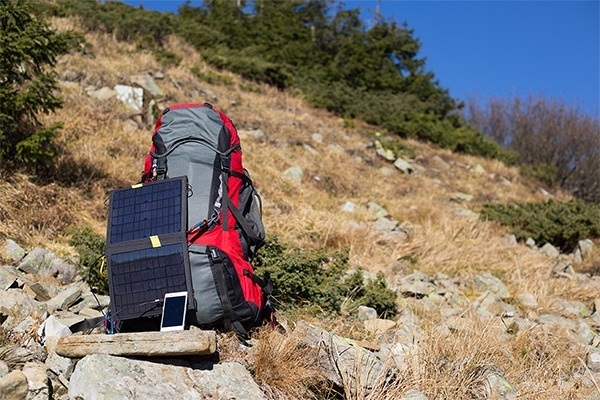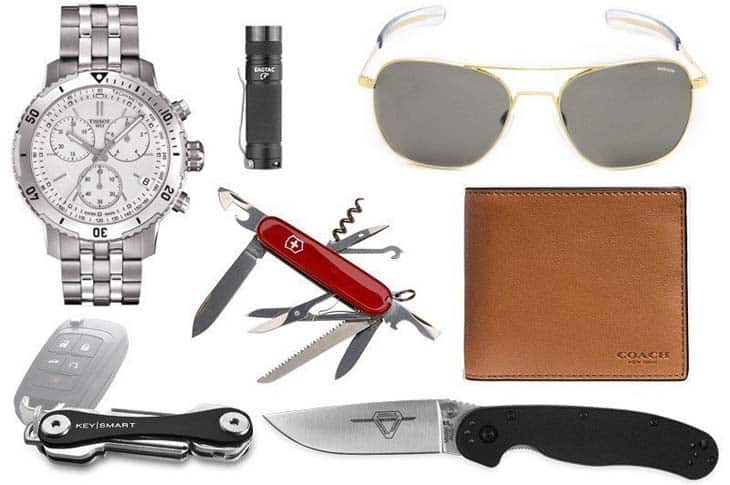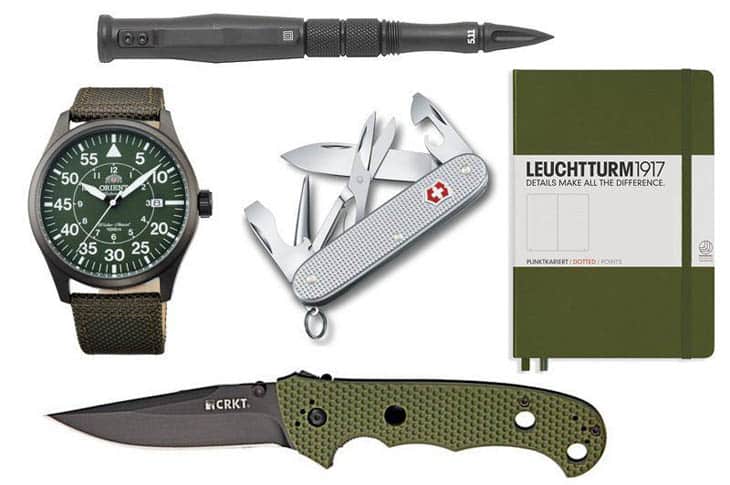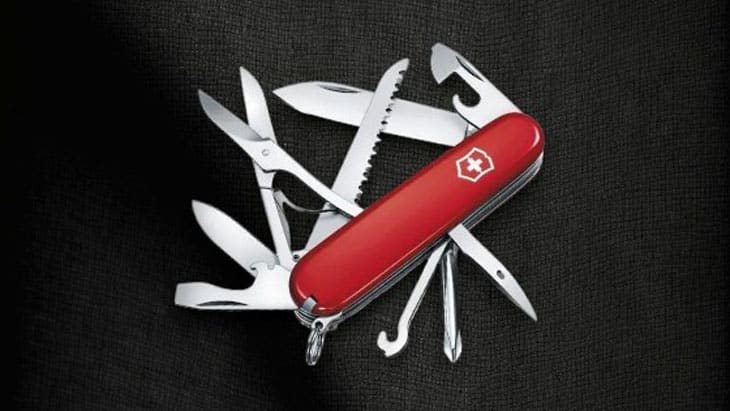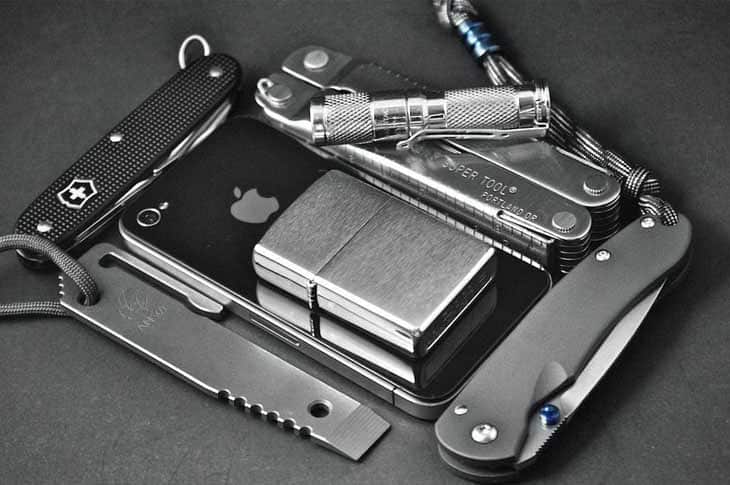The Best Packraft: Go Places You Never Could Before
Why are we talking about packrafts here on a survival site? …Because adding a high quality packraft to your survival kit or bug out bag is a game changer.
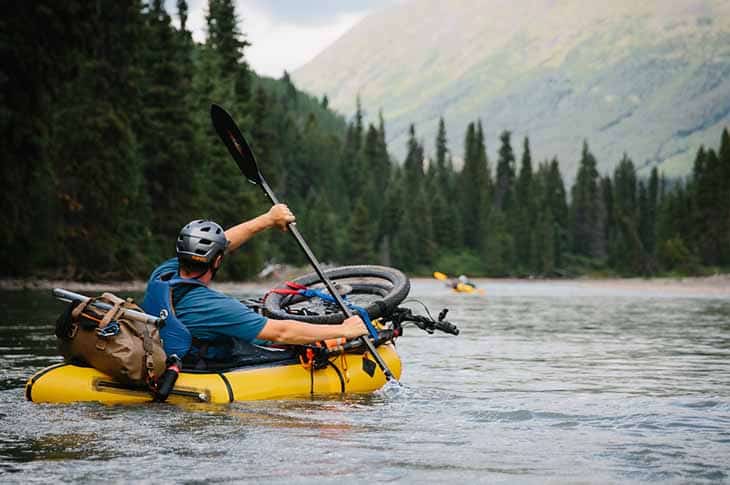
Here’s how.
You can travel farther and easier than you can with other types of watercraft. They provide access to waterways that would normally be difficult, if not impossible, to get to.
So they open up all kinds of survival and bug out opportunities by allowing you to go places you wouldn’t have considered before. And they can be a significant aspect of self-rescue, a critical part of wilderness survival skills, and survival skills in general.
New innovations combine lightweight and durable materials with designs that create more rigidity.
Nowadays packrafts perform more like kayaks rather than old flimsy dinghies.
So, don’t mistake these things for blow-up pool toys. They are serious watercraft, built to handle abuse from the likes of branches and sharp rocks.
Some new packrafts weigh less than 5 lbs, and roll up to the size of a small tent.
It’s this combination of ultralight construction and durability that make them a game changer for survivalists.
Even Special Operations teams have taken notice of the packraft’s versatility.
Now you can add water transportation to your backpack or bug out bag. This gives you the ability to easily cross lakes, navigate moderate rivers (even with Class I or II rapids), swamps and flood stricken terrain.
You can combine land with water miles for a much longer travel distance that may have been unthinkable before, all from your backpack.
Packraft manufacturers make a wide variety of designs, some made for calm lakes while others built for Class V rapids.
So which one is best for you? The best packraft for you all depends on the type of water you plan on encountering and how much weight you’re willing to add to your backpack.
So let’s take a look at some things you should consider before buying one, as well as our top picks.
- TOP PICK: Kokopelli Rogue Lite Packraft
- BEST BUG OUT BAG OPTION: Alpacka Scout Packraft
- MOST RUGGED: Kokopelli XPD Packraft
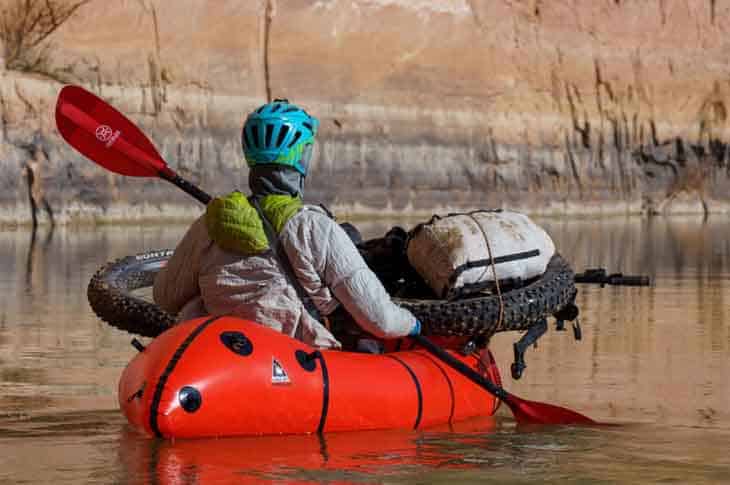
Which Type of Packraft Is Best For Your Situation
Cruisers – Favorites of The Ultralight Crowd
This type of inflatable boat is built for calmer flatwater. You would consider this type for recreational use, having fun casually paddling around the lake at the cottage.
They typically look more like open-style dinghies and less like covered kayaks. They also have less stability than the whitewater type.
The Cruisers do not provide the same high performance as a whitewater or adventure type but they do provide the best portability.
Because they do not require thicker materials, they are considerably lighter. They also compress down to a much smaller package.
As a consequence, they are the preferred choice for ultralight backpackers.
Whitewater Packrafts – Handles Just About Anything
These are the beasts made for shooting rapids. They need to be more durable than Cruisers because of the abuse they are subjected to.
Whitewater packrafts come with more design features like spray decks (like kayaks), adjustable seats and sometimes thigh straps.
Because they have closed in decks, they have limited space for your pack. So you have to be more strategic with stowing your gear.
The extra features along with the more durable materials make whitewater packrafts heavier. Some are still light enough for backpacking comfortably, but they are not nearly as portable as the Cruisers.
But they are much easier to carry long distances than hardshell kayaks.
Adventure Packrafts – The Best of Both Worlds
Adventure packrafts fill the void between Cruisers and Whitewater packrafts.
Designed for those who need something more rugged and has a higher performance than a Cruiser, but is lighter and more portable than a Whitewater type.
Adventure types tend to be stripped down versions of the Whitewater types while retaining Whitewater’s more rigid design.
The Adventure types are quickly becoming a very popular product segment.
They save weight by using lighter, but still durable materials. And they remove some of the weighty features like adjustable seating, thigh straps and even spray decks (some Adventure models still have spray decks).
This creates packrafts that can navigate small to mid-size rapids and handle backcountry wear-and-tear. All the while being small enough to fit in a backpack and light enough to carry long distances.
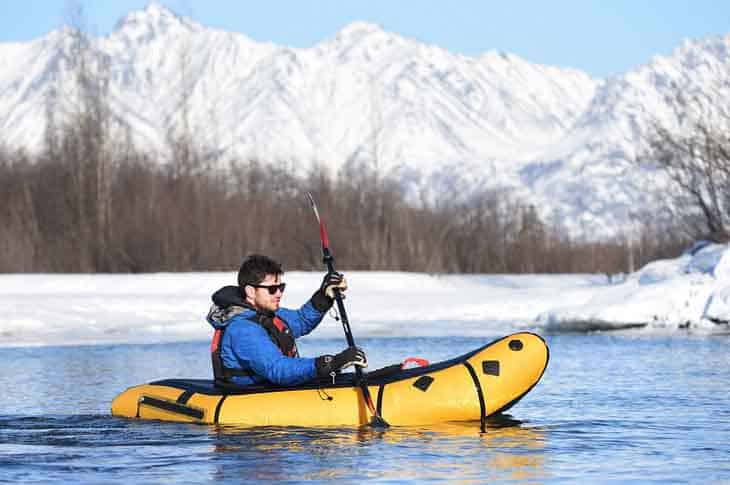
Things That Will Help You Choose One Packraft Over Another
Weight
This comes down to how much weight you are willing to carry.
If you plan on carrying this in your backpack on long hiking trips then weight becomes very important.
Also keep in mind, packrafting requires some extra gear (like a paddle, pfd, throw bag, helmet, etc.) which will add some weight too.
If you lean towards ultralight backpacking and want flatwater capability, then Cruisers usually come in the 2 to 4 lbs range.
If you need some ruggedness, the Adventure type will be more your style. You can expect a weight range of 5 to 8 lbs.
For a good competent whitewater type, they range from 8 to 20 lbs.
Durability
No matter how hard you try to avoid it, eventually your packraft will come into contact with branches, floating or submerged logs, and rocks. So durable materials are essential.
The more adventurous you get, the more durability you’ll need.
The raft’s tubing and flooring will typically be made from waterproof coated nylon (sometimes reinforced with Kevlar).
Fabric thickness is measured in “Denier” (D). The material thicknesses typically range from a minimum 70 D all the way to 1000 D. The higher the more durable (but also heavier).
Handling
Handling is a trade-off between wide (provides more stability), and narrow (provides less water resistance).
So you want something that is wide enough to create a stable watercraft but also narrow enough to create smooth hydrodynamics through the water.
That’s where good design comes into play – finding the right balance between the two.
Self Bailing
This feature found on some models (especially the whitewater), allows water that splashes into the raft to flow back out.
That way water doesn’t get trapped and accumulate inside the raft.
You can have the self bailing feature in an inflatable raft because the floor is not what’s keeping you afloat. The air-filled pontoons (side walls) are.
The only issue with the self-bailing feature is a little water is also free to flow into the raft as well. So the floor will always be a little wet.
Load Capacity
Like any watercraft, there is only so much weight it can carry.
You need to consider how much you weigh along with your pack and gear.
Make sure you consider the maximum load capacity and figure out if it can handle you and everything you plan on carrying.
Load capacities typically range from about 200 lbs for small cruisers to several hundred pounds for some adventure and whitewater models.
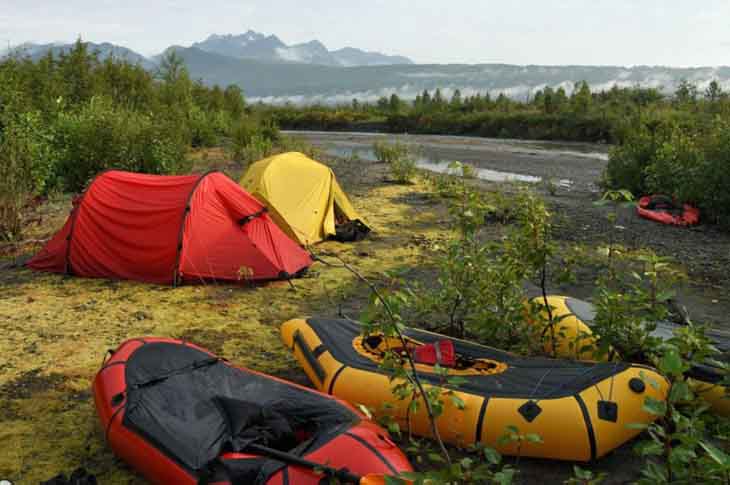
Features You Need To Know About So You Can Get Everything You Want
Spray Decks and Skirts
Spray decks are covers over the top of the raft that create a partially closed-in cockpit. They prevent water from splashing into your raft.
Spray skirts are worn around the waist and are usually made from neoprene.
They attach to the spray deck either by zipper, elastic cinch or velcro.
Skirts and spray decks work together to help keep you and your gear dry.
Gear Storage
Open deck designs allow you to store your gear in front of you and/or behind you.
Many models also have d-rings so you can tie down your gear.
Since storage is limited, many higher end models provide a zippered access to the pontoon’s interior so you can store gear inside it.
But note, that gear stored inside the pontoon won’t be accessible while the packraft is in use.
Inflation Setup
Packrafts are way too big to inflate with your breath.
So they are designed to use inflation bags. They help you take large volumes of air and push it into the raft’s pontoon.
Many packrafts also come with small tube valves so you can also blow into the pontoon and optimize the amount of air you want.
With some models, the inflation bag that comes with the packraft doubles as a stuff sack or dry bag.
Thigh Straps
Common to whitewater packrafts, thigh straps help paddlers stay secure in the boat, and increase control in turbulent waters.
For safety reasons, make sure the thigh straps are quick-release.
This is in case you need to exit the craft quickly (like in the case of a roll-over).
Seats
Sitting low in your packraft can make paddling long distances uncomfortable. It also makes it inefficient.
So most models come with some sort of seat. Typically they are either inflatable or foam pads.
They come either built into the boat or they are detachable.
Make sure you find out if it comes with the boat or whether you have to order it as a separate option.
Compression Straps
Your raft should come with compression straps so you can roll it up and keep it that way in order to easily fit in your backpack.
You’ll find most come with straps made from either 3/4″ or 1″ webbing.
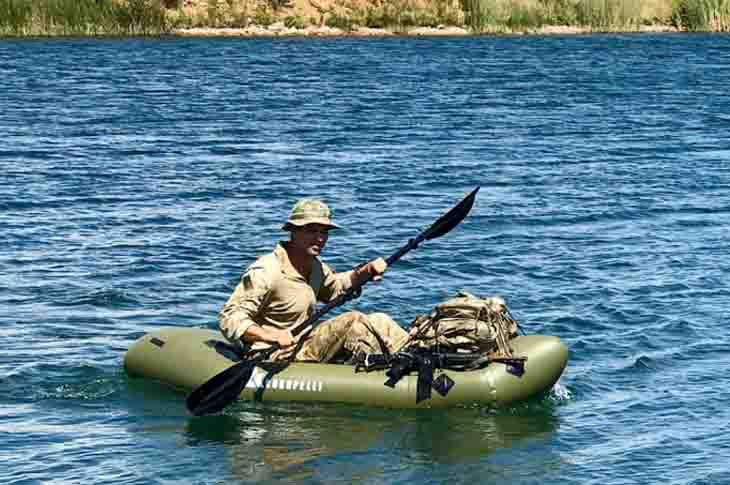
The Best Packraft – Water Is No Longer A Barrier
1. Kokopelli Rogue Lite Packraft – Top Overall Pick
This award winning, adventure style packraft has hit the sweet spot when it comes to combining ruggedness and lightweight.
It weighs in at 5.2 lbs and packs down to a stingy 8 x 13 inch roll.
That’s smaller than many lightweight backpacking tents.
So the Rogue Lite is ready to stuff into your backpack and take you anywhere.
Adventure style packrafts combine the sturdiness of whitewater models and the stripped down weight savings of Cruisers.
But Kokopelli has not skimped on much with the Rogue Lite.
The boat’s extra large 12″ diameter sidewalls are made from sturdy 210d TPU-nylon.
The highlight for this ultralight boat is the Kevlar reinforced nylon blend floor, providing even more protection against abrasions and punctures.
The main pontoon uses a Leafield D7 valve which is the most durable in the world.
You get a 4 inch thick inflatable seat (no backrest) for a more comfortable paddling position, an inflation bag and compression straps.
The design also includes 4 mil-spec webbing d-ring attachment points towards the bow of the raft so you can easily strap down your pack, dry bag or even a mountain bike.
If you need more storage space, then you can get this Kokopelli packraft with the optional TiZip water tight zipper installed in the pontoon.
So how much weight can this ultralight adventure packraft handle?
It can take up to 300 lbs.
The Kokopelli Rogue Lite is built tough for multi-day, ultralight trips, and it makes our best overall pick.
2. Alpacka Scout Packraft – Best Bug Out Bag Option
Wouldn’t you want to be able to add more bug out capabilities without adding a lot of extra weight?
The Alpacka Raft Scout accomplishes that by being so small and light that you may not even notice it in your bug out bag.
It weighs only 3 lbs 4 oz.
It rolls up to 5 x 15 inches.
That’s smaller than a roll of paper towels.
Known for its fast packing, this boat is perfect for crossing rivers, cruising flat water and canyoneering.
The Alpacka packraft is backcountry-ready. It’s built with 210d TPU-nylon for the sidewalls and 420d TPU-nylon (treated both sides) for the floor.
The Scout doesn’t have d-ring tiedowns like the Rogue-Lite. It has only a grab handle in the stern.
It’s also a bit smaller than the Rogue-Lite and has a load capacity of 225 lbs. If you get the optional cargo fly, the load capacity increases to 275 lbs.
It comes in a gray color for lower visibility, keeping you stealthy.
The Alpacka Scout is a perfect choice as a bug out bag ready, ultralight watercraft that can add water crossing capabilities to your bug out efforts.
3. Kokopelli XPD Packraft – Most Rugged Adventure Packraft
Based on the Rogue Lite platform, the Kokopelli XPD is designed with input from Special Operations teams.
This is the most versatile packraft available and is built for harsh terrain.
Whereas the Rogue Lite uses 210d TPU-nylon for its sidewalls, the XPD bumps that up to 1000d reinforced PVC. So this boat is built as tough as nails.
That extra toughness increases the overall weight of the boat to 13 lbs. It still packs down to a reasonable size that fits in a backpack.
Additional d-ring tie down points have been added for a total of 6 (4 in front, 2 in back).
It also comes with the standard 4 inch inflatable seat, repair kit and inflation bag.
The XPD’s load capacity is 300 lbs.
This model’s green color creates lower visibility, if stealth is a priority for you.
So, if you’re rough on your gear or you need serious bug out gear that can handle nasty terrain, the Kokopelli XPD provides the extra toughness you’re looking for.
Survivalists and preppers are adaptable people. Borrowing ideas, skills and gear from other parts of life is our hallmark of resourcefulness.
So when a lightweight, high performance raft that’s perfect for your bug out bag comes along, we pay attention.
And we thank the individuals (whoever you are) that decided one day, they wanted to go down a river in a new kind of raft …with a mountain bike strapped across it. Kudos.
Complete Your Kit
See our “Survival Gear List” for the most complete compilation of gear you need in your survival kit.
Paddles
Second only to the packraft itself, paddles are the next important pieces of equipment.
A good quality kayak paddle works perfectly.
You should consider the collapsible kind so they fit more easily in your backpack.
And of course, weight is important here too. Lightweight options range from cheaper aluminum to more expensive carbon fiber.
PFD’s
Don’t skip on a personal flotation device. There are many lightweight, compact products available.
They can also pull double duty as a seat or back rest at camp.
Repair Kit
Most models come with a repair kit. But if they don’t, make sure you get one, or put one together.
We hope for the best, but we plan for the worst.
Helmet
This is a critical piece of gear if you plan on tackling whitewater.
Knife
Another piece of critical gear if you’re dealing with whitewater.
You need to be able to cut away from anything that could pin you underwater.
Throwbag
This is a bag containing a safety rope that you can throw towards a rescuer (or towards someone needing rescue).
They come in different lengths so look for one that is at least 30 feet long.
Wet Suit or Dry Suit
This one is up to you. If you want to spend any length of time in whitewater, a wet suit or dry suit is highly recommended.
They are indispensable in colder weather to help keep you warm.
Dry bag
Self-explanatory. Roll top dry bags will keep your gear dry in the boat.







